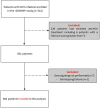Hepatitis C subtype distribution in chronically infected patients with mild liver fibrosis in France: the GEMHEP study
- PMID: 31364570
- PMCID: PMC6625182
- DOI: 10.1017/S0950268819001225
Hepatitis C subtype distribution in chronically infected patients with mild liver fibrosis in France: the GEMHEP study
Abstract
Treatment options for Hepatitis C infection have greatly improved with direct-acting antiviral (DAA) combinations achieving high cure rates. Nevertheless, the cost of this treatment is still high and access to treatment in many countries has been preferentially reserved for patients with more severe fibrosis (F3 and F4). In this French nationwide study, we investigated the epidemiological characteristics and genotype distribution of hepatitis C virus (HCV) in treatment-naive patients with METAVIR fibrosis stages between F0 and F2 in order to identify patient profiles that became eligible for unrestricted treatment in a second period. Between 2015 and 2016 we collected data from nine French university hospitals on a total of 584 HCV positive patients with absent, mild or moderate liver fibrosis. The most represented genotypes were genotype 1b (159/584; 27.2%), followed by genotype 1a (150/584; 25.7%); genotype 3 (87/584: 14.9%); genotype 4 (80/584; 13.7%). Among genotype 4: 4a was predominantly encountered with 22 patients (27.5% of genotype 4). Genotypes 1b and 1a are currently the most frequent virus types present in treatment-naive patients with mild fibrosis in France. They can be readily cured using the available DAA. Nevertheless, non-a/non-d genotype 4 is also frequent in this population and clinical data on the efficacy of DAA on these subtypes is missing. The GEMHEP is the French group for study and evaluation of viral hepatitis on a national scale. Data collection on epidemiological and molecular aspects of viral hepatitis is performed on a regular basis in all main French teaching hospitals and serves as a basis for surveillance of these infections. Analysis and trends are regularly published on behalf of the GEMHEP group. Data collection was performed retrospectively over the 2015-2016 period, covering nine main university hospitals in France. A total of 584 hepatitis C positive patients were included in this study. Genotyping of the circulating viruses showed a high prevalence of genotypes 1b and 1a in our population. The epidemiology of hepatitis C is slowly changing in France, particularly as a consequence of the rise of 'non-a non-d' genotype 4 viruses mainly originating from African populations. More data concerning treatment efficacy of these genotypes is needed in order to guide clinical care.
Keywords: Epidemiology; HCV genotypes; fibrosis; treatment-naive HCV.
Conflict of interest statement
Authors declare no conflicts of interest relevant to this work.
Figures



Similar articles
-
Hepatitis C virus genotypes in France: relationship with epidemiology, pathogenicity and response to interferon therapy. The GEMHEP.J Viral Hepat. 1999 Nov;6(6):435-43. doi: 10.1046/j.1365-2893.1999.00187.x. J Viral Hepat. 1999. PMID: 10607261
-
Hepatitis C virus type 1b (II) infection in France and Italy. Collaborative Study Group.Ann Intern Med. 1995 Feb 1;122(3):161-8. doi: 10.7326/0003-4819-122-3-199502010-00001. Ann Intern Med. 1995. PMID: 7810932
-
Cost-effectiveness of Early Treatment of Hepatitis C Virus Genotype 1 by Stage of Liver Fibrosis in a US Treatment-Naive Population.JAMA Intern Med. 2016 Jan;176(1):65-73. doi: 10.1001/jamainternmed.2015.6011. JAMA Intern Med. 2016. PMID: 26595724 Free PMC article.
-
Literature review of the distribution of hepatitis C virus genotypes across Europe.J Med Virol. 2016 Dec;88(12):2157-2169. doi: 10.1002/jmv.24573. Epub 2016 Jul 11. J Med Virol. 2016. PMID: 27171396 Review.
-
Treatment of chronic hepatitis C in Asia: when East meets West.J Gastroenterol Hepatol. 2009 Mar;24(3):336-45. doi: 10.1111/j.1440-1746.2009.05789.x. J Gastroenterol Hepatol. 2009. PMID: 19335784 Review.
Cited by
-
Genotype Distribution and Characteristics of Chronic Hepatitis C Infection in Estonia, Latvia, Lithuania, and Ukraine: The RESPOND-C Study.Medicina (Kaunas). 2023 Aug 30;59(9):1577. doi: 10.3390/medicina59091577. Medicina (Kaunas). 2023. PMID: 37763696 Free PMC article.
-
'Unusual' HCV genotype subtypes: origin, distribution, sensitivity to direct-acting antiviral drugs and behaviour on antiviral treatment and retreatment.Gut. 2024 Aug 8;73(9):1570-1582. doi: 10.1136/gutjnl-2024-332177. Gut. 2024. PMID: 38782565 Free PMC article. Review.
-
Chronic Infection with Hepatitis C Virus Subtype 1g in a Japanese Patient Successfully Treated with Glecaprevir/Pibrentasvir.Intern Med. 2022 May 15;61(10):1537-1543. doi: 10.2169/internalmedicine.8673-21. Epub 2021 Dec 11. Intern Med. 2022. PMID: 34897154 Free PMC article.
-
I Can C Clearly Now, the End Is Near.Dig Dis Sci. 2025 Jan;70(1):26-28. doi: 10.1007/s10620-024-08754-6. Epub 2024 Dec 2. Dig Dis Sci. 2025. PMID: 39621184 No abstract available.
References
-
- Blach S, Zeuzem S, Manns M, Altraif I, Duberg A-S, Muljono DH, et al. (2017) Global prevalence and genotype distribution of hepatitis C virus infection in 2015: a modelling study. Lancet Gastroenterology and Hepatology 2, 161–76. - PubMed
-
- Pioche C, Pelat C, Larsen C, Desenclos J-C, Jauffret-Routide M, Lot F, et al. (2016) Estimation de la prévalence de l'hépatite C en population générale, France métropolitaine, 2011. Bulletin Epidémiologique Hebdomadaire, 224–9.
-
- Pol S, Bourliere M, Lucier S, Hezode C, Dorival C, Larrey D, et al. (2017) Safety and efficacy of daclatasvir-sofosbuvir in HCV genotype 1-mono-infected patients. Journal of Hepatology 66, 39–47. - PubMed
Publication types
MeSH terms
Substances
LinkOut - more resources
Full Text Sources
Medical
Miscellaneous

